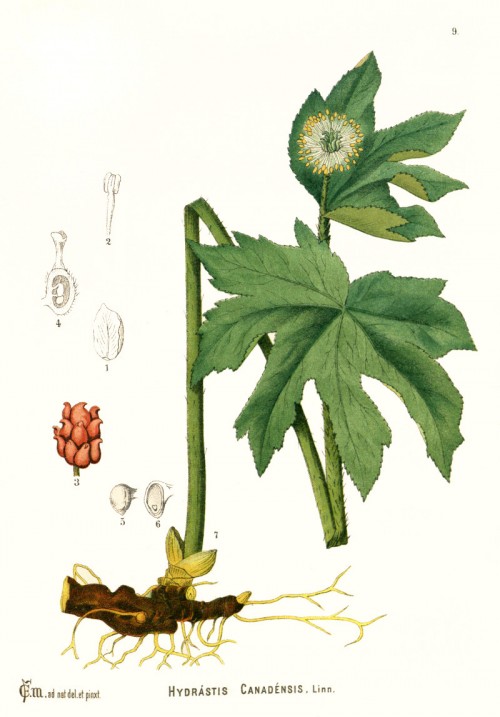Hydrastis canadensis L. - Ranunculaceae - goldenseal, orange root, hydrastis du Canada (french), Kanadische Orangewurz
Perennial herb, up to 50cm tall, native to Northern America; rhizomes with tough fibrous roots; stem unbranched, pubescent; basal leaves often quickly deciduous, cauline leaves with variously incised lobes, margins singly or doubly serrate; flowers showy white; berries dark red.
„Native Americans used Hydrastis canadensis medicinally for treating cancer, whooping cough, diarrhea, liver trouble, earaches, sore eyes, fevers, pneumonia, heart trouble, tuberculosis, chapped or cut lips, and dyspepsy; to improve appetite; and as a tonic, and as a wash for inflammation (D. E. Moerman 1986).“
http://www.efloras.org/florataxon.aspx?flora_id=1&taxon_id=220006616
„Hydrastis or goldenseal, one of the most popular medicinal herbs in the U.S.A., is used in mild pathological conditions like cold and flu, based on the pharmacological properties of its active components, berberine (anticholinergic, antisecretory, and antimicrobial) and β-hydrastine (astringent). We previously reported the relaxant effect of a total ethanolic extract of hydrastis on carbachol precontracted isolated guinea pig trachea, and with the present study, using the same experimental model, we aimed at evaluating the contribution of its major alkaloids, berberine, β-hydrastine, canadine and canadaline to the total effect. Furthermore, using specific pharmacological tools, like timolol and xanthine amine congener, we attempted to elucidate its mechanism of action. The EC50 of berberine, β-hydrastine, canadine and canadaline, were 34.2±0.6, 72.8±0.6, 11.9±1.2 and 2.4±0.8 μg/ml, respectively. Timolol effectively antagonized the effect of canadine (EC50=19.7±3.0 μg/ml) and canadaline (EC50=17.1±1.2 μg/ml) but not that of berberine and β-hydrastine, while xanthine amine congener antagonized the effect of β-hydrastine (EC50=149.9±35.3 μg/ml) and canadaline (EC50=26.1±3.0 μg/ml) but not that of berberine and canadine. Besides, the hydrastis extract, at concentrations between 0.01 and 0.1 μg/ml, potentiated the relaxant effect of isoprenaline on carbachol-precontracted isolated guinea pig trachea. These data, which are insufficient to draw definite mechanistic conclusions, indicate that the aforementioned alkaloids may act by interacting with adrenergic and adenosinic receptors.“
[Relaxant effects of Hydrastis canadensis L. and its major alkaloids on guinea pig isolated trachea., Abdel‐Haq, H., Cometa, M.F., Palmery, M., Leone, M.G., Silvestrini, B., Saso, L., Pharmacology & toxicology, 87(5), 2000, 218-222]
Goldenseal roots contain the isoquinoline alkaloids hydrastinine, berberastine, tetrahydroberberastine, canadaline, berberine, hydrastine, and canadine.
[Chemical comparison of goldenseal (Hydrastis canadensis L.) root powder from three commercial suppliers., Weber, H.A., Zart, M.K., Hodges, A.E., Molloy, H.M., O'Brien, B.M., Moody, L.A., Smith, C.S., Journal of agricultural and food chemistry, 51(25), 2003, 7352-7358]
Berberine isolated from the roots of H.canadensis showed antimicrobial activity against the oral pathogens Streptococcus mutans and Fusobacterium nucleatum.
[Antimicrobial constituents from goldenseal (the Rhizomes of Hydrastis canadensis) against selected oral pathogens., Hwang, B.Y., Roberts, S.K., Chadwick, L.R., Wu, C.D., Kinghorn, A.D., Planta medica, 69(7), 2003, 623-627]
H.canadensis, used traditionally for the treatment of gastrointestinal ailments, was screened for in vitro antibacterial activity against 15 strains of Helicobacter pylori. „The crude methanol extract of H. canadensis rhizomes was very active, with an MIC50 of 12.5 µg/ml. Two isoquinoline alkaloids, berberine and β-hydrastine, were identified as the active constituents, and having an MIC50 of 12.5 and 100.0 µg/ml, respectively.“
[In vitro susceptibility of Helicobacter pylori to isoquinoline alkaloids from Sanguinaria canadensis and Hydrastis canadensis., Mahady, G.B., Pendland, S.L., Stoia, A., Chadwick, L.R., Phytotherapy Research, 17(3), 2003, 217-221]
As shown using midazolam as a phenotypic probe, pharmacokinetic parameters revealed significant inhibition of CYP3A by goldenseal. „These findings suggest that significant herb-drug interactions may result from the concomitant ingestion of goldenseal and CYP3A substrates.“
[Supplementation with goldenseal (Hydrastis canadensis), but not kava kava (Piper methysticum), inhibits human CYP3A activity in vivo., Gurley, B.J., Swain, A., Hubbard, M.A., Hartsfield, F., Thaden, J., Williams, D. K., Tong, Y., Clinical Pharmacology & Therapeutics, 83(1), 2008, 61-69]
„… the roots of H. canadensis contain higher levels of alkaloids than the aerial portions, but the aerial portions synergize with berberine more significantly than the roots. Furthermore, extracts from the aerial portions of H. canadensis contain efflux pump inhibitors, while efflux pump inhibitory activity was not observed for the root extract. The three most abundant H. canadensis alkaloids, berberine, hydrastine and canadine, are not responsible for the efflux pump inhibitory activity of the extracts from H. canadensis aerial portions.“
[Goldenseal (Hydrastis canadensis L.) extracts synergistically enhance the antibacterial activity of berberine via efflux pump inhibition., Ettefagh, K.A., Burns, J.T., Junio, H.A., Kaatz, G.W., Cech, N.B., Planta medica, 77(8), 2011, 835] http://www.ncbi.nlm.nih.gov/pmc/articles/PMC3100400/

Millspaugh,C.F., American medicinal plants, vol.1, t.9 (1892)
http://plantgenera.org/species.php?id_species=540763
